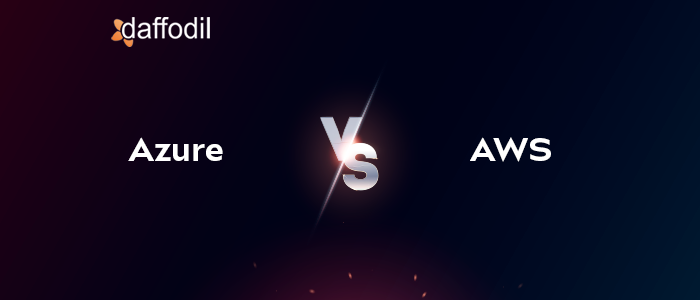
Cloud service wars in a serverless architecture are not new. Serverless computing is a software design platform that hosts applications through third-party service doing away with the need for server management by the developer.
The reason why companies should invest in serverless architecture or computing is that it lets the teams focus on core business rather than devoting time in building and maintaining the infrastructure.
The main advantage is of course; companies don’t have to pay the vendor for any fixed bandwidth. They pay as per-use that can be scaled up or down at any time. It also eliminates the basic infrastructure management such as OS maintenance, patching, server provisioning, and more.
In this article, we will run a comparison between Azure and AWS cloud service for serverless architecture.
Benefits of using AWS cloud service
Amazon Web Services provides on-demand cloud computing platforms on a pay-per-use basis. Among the top public cloud providers in the world – AWS boasts of a strong network of data centers. A few AWS features to talk about are next-generation tooling, SageMaker which is used to build, label, and deploy machine learning tools.
Then there is Lex which is used for Alexa services which provide auto speech recognition (ASR) while Greengrass IoT messaging service is used for serverless computing. Now, companies have all these tools and features at their disposal when they choose to go for AWS cloud computing solutions.
They can build a better business by creating applications with these tools for more effective user engagement. AWS also offers a range of benefits on the DevOps. Teams can use CodeCommit, CodeDeploy, and CodePipeline for developing and implementing code.
The main feature of AWS in serverless is Lambda – wherein a unit of code is used for a task. The companies can lease this very code until the tasks are carried out. AWS only charges for the memory space used in the execution of the task. This high performance and effective tool is used by giants like Netflix. Just so, you know how big and powerful Lambda is.
AWS boasts of many AI-based tools as well such as DeepLens which is an AI-powered camera used for deploying machine learning for the optical character, image, object recognition. Another tool is the open-source deep-learning library – Gluon for both technical and non-technical teams. It solves the need for training neural networks for individuals without AI programming know-how.
Cons of using AWS cloud service
With all the benefits of AWS, there are still some disadvantages that you need to be aware of. The most important is their cost structure especially for companies running heavy workloads. Another drawback is the default limits on resources such as images, snapshots, and more. Companies using AWS can only use a limited amount of instances per area. Besides AWS also charges you for immediate support and the fee structure is divided into three categories namely: developer, business, and enterprise.
Also Read: GCP to AWS Migration: Why and How to Make the Move
Benefits of using Azure cloud service
The Azure suite offered by Microsoft is a package that includes SQL Server, Sharepoint Office, Windows Server, .Net, Dynamics Active Directory, and more. So, if you’re going for Azure cloud computing then you can get the benefit of availing all these features. Besides, many companies that have used these features and tools before are at a greater comfort of being familiar with these tools, and hence going for Azure is a preferred choice for them. Moreover, Microsoft offers heavy discounts to companies that are already using these features and opt to go for Azure.
The serverless architecture in Azure offers powerful DevOps tools that allow developers to build applications in their environment. This means companies can create, test, deploy applications and even build Kubernetes-based applications.
The auto-package management helps in trigger-building and deploying Azure Web apps. Azure also came up with Azure Functions as an answer to AWS Lambda. And it is used by many across the globe for faster code development and orchestration challenges.
Besides, you can build, train, deploy applications on Azure Machine Learning. Add to that you can also combine serverless apps with Azure’s AI-backed machine learning algorithms. Azure Cognitive Services by Microsoft is cognitive computing that lets the serverless application to see, hear, speak and interpret a user’s needs.
Cons of using Azure cloud service
The biggest disadvantage of using Azure is probably the vendor lock-in. Besides, many companies have also observed issues with Azure Functions wherein deploying, testing, and executing a function in environments outside of Azure were found to be cumbersome. Lack of Hyper-V snapshot support is another major drawback in Azure because of which you end up taking snapshots of VMs and go back to the previous state. Transferring large files is kind of slow in Azure and custom images need to be VM-ready to be run on Azure. Lack of integrated backup is another disadvantage in Azure.
Also Read: All About AWS Outposts and its Benefits
Looking for the right serverless strategy for your business?
It’s important to come up with a strategy when it concerns anchoring your business. For custom-applications built for serverless architecture – cloud service providers are a boon that can provide impressive advantages in serverless computing. Evolve your business with the right public cloud server. For more information on which one to pick for your organization get in touch with our team of cloud experts here.



